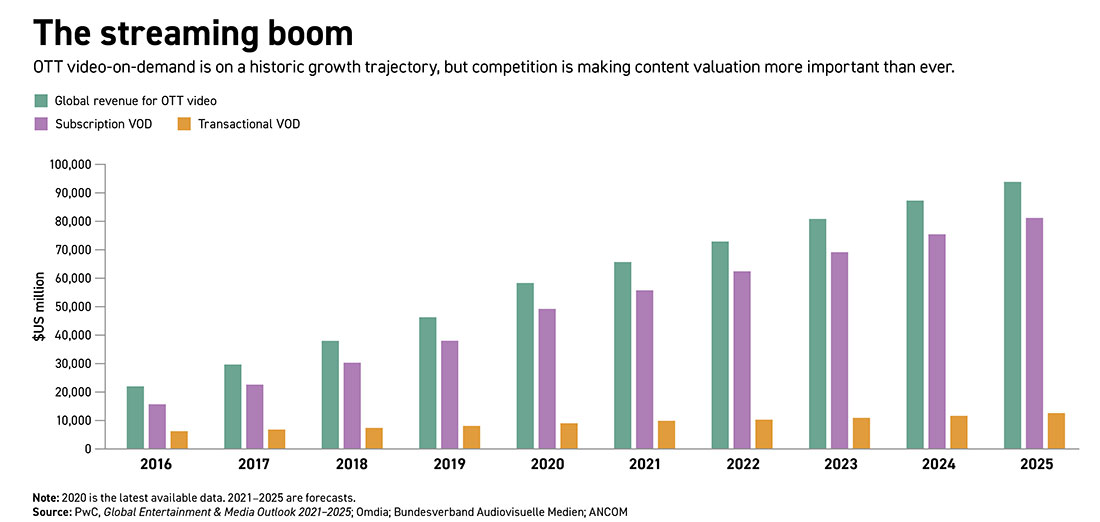
READ MORE: The real value of video content (S+B)
With spend on content projected to reach an astonishing $230 billion globally in 2022, is a new formula needed to justify its value?
Consultancy PwC thinks so and has come up with a three-point plan. It’s broad and will vary from streamer to streamer, and even market by market, but the prevailing approach won’t guarantee success — or even survival — as the streaming wars rage on.
“With rights holders pulling their content from streaming services in droves to offer it on their own, the rules of content ROI have changed dramatically,” PwC execs Kim David Greenwood, Kate Kennard and Chris Mowry state.
“The days when companies could count on a stream of revenue during theatrical ‘windows’ — box office, DVD, premium and basic cable, broadcast syndication — are coming to an end. So are the cushy licensing deals that allowed poorer-performing titles to be packaged with blockbusters.
“In this new world, every content asset matters. One clunker can mean a mass subscriber exodus. That’s why we created a three-pronged formula for content valuation that can help drive meaningful and sustainable ROI.”

The formula is simple and consists of three variables: demand, expansion and exclusivity.
Read more: Looks Like $230 Billion Will Be Spent on Content in 2022
Demand
Understanding demand in the era of streaming is not easy. Most platforms opt not to make detailed viewership data public. There are independent analytics from firms like Ampere and Parrot, however, and these can serve as a good starting point, says PwC.
The next step, as PwC outlines, is to aggregate all forecasted and actual revenue-based metrics (such as ticket sales and total views) together with social-impact metrics (such as social media impressions) and quality metrics (such as awards). That will help create your own demand metric for current and future content.
Expansion
Content that can be expanded into sequels, spin-offs, and TV series tends to be more valuable than “one-and-done” shows and films. As PwC wittily observes, Titanic may have taken $2.2 billion at the box office but it hasn’t sold a lot of merch. Harry Potter on the other hand is a multi-billion dollar bonanza that keeps on giving.
“In an industry projected to spend $230 billion on content globally in 2022, megadeals have become routine salvos in the fight for streaming customers.”
Examples include: Netflix shelling out $450 million for the rights to Knives Out 2 and 3; Universal Pictures and NBCU’s $400 million purchase of the rights for a new franchise of The Exorcist, for Peacock; and ViacomCBS spending $900 million on another six seasons of South Park, as well as 14 movies set in the South Park universe.
CHARTING THE GLOBAL MARKETPLACE:
Big content spends, tapping emerging markets, and automated versioning: these are just a few of the strategies OTT companies are turning to in the fight for dominance in the global marketplace. Stay on top of the business trends and learn about the challenges streamers face with these hand-curated articles from the NAB Amplify archives:
- How To Secure the Next Billion+ Subscribers
- Think Globally: SVOD Success Means More Content, Foreign Content and Automated Versioning
- How Does OTT Gain Global Reach? Here’s Where to Start.
- Governments Draw Battlelines To Curb the US Domination of SVOD
- Streaming Content: I Do Not Think You Know What That Word Means
IP like this can be mined for years and it pulls in the punters. PwC notes that 29% of Disney+ subscribers who signed up during the launch of The Mandalorian’s second season had previously subscribed to Disney+, concluding: these customers were joining back up to watch one particular show that held the promise of more to come.
Exclusivity
The third prong in the accountant’s formula is exclusivity. This continues to play a major role in helping companies attract customers to their streaming platforms. Disney, for instance, pulled Marvel content from Netflix in late 2019, which became a huge driver of customer acquisitions for Disney+.
Applying This Formula to the Streamers
PwC indicates that content will be valued by streamers differently according to their business model strategies. Some companies will offer content for free with the goal of increasing viewership and merchandising sales. Others, for example, will only want to increase subscriber revenue.
Taking just Netflix, which is still the streaming king with 222 million subscribers compared to Amazon Prime Video’s 175 million, followed by Disney+ with 120 million, and Peacock’s roughly 54 million. PwC is projecting Netflix to spend more than $17 billion on content in 2022, a 25% increase from 2021 and a 57% increase from 2020. Yet even with hit shows like Glee and The Office disappearing from the platform, Netflix still has the largest and most robust content library in the world.
The streaming giant’s strategy is to continue building that library with its own content, particularly shows tailored for international customers like Narcos: Mexico and Money Heist.
“Proper content valuation represents a fundamental strategic choice for the future. When used effectively, the formula can help dictate and frame the considerations and the choices made about content acquisition and development.”
— PwC
PwC’s free advice: “For every content investment made, Netflix must ask itself: Can this piece of content be expanded to realize its full value? Can it drive higher ARPU via other revenue streams such as merchandising and new experiences? In saturated markets like North America, where Netflix already has more than 75 million subscribers, expansion is the most important variable: Netflix must find new opportunities for growth beyond monthly subscriptions.”
Netflix recently launched an online shop for branded merchandise like Stranger Things hoodies. That could boost revenue in saturated markets. In markets where Netflix is still trying to add subscribers, the demand and exclusivity variables take on greater importance.
PwC brackets Disney+, HBO Max and Peacock into a group it calls “nostalgists.”

“Whether it’s Disney+ with Star Wars, HBO Max with The Sopranos, or Peacock with The Office, the formula revolves around the sure and familiar comfort of hit shows and movies. The nostalgic appeal of such content is also multigenerational: Star Wars pulls in older viewers who fondly remember the original 1977 film while simultaneously hooking younger fans with The Mandalorian.”

So, per PwC, while demand and exclusivity matter to this group, expansion is the most important variable: “Proven hits have established universes of fans ready to give up their time and money for spin-offs, sequels, and merchandise.”
A third group including Meta, Apple, Google and Amazon see content as a means to an end. They aren’t concerned with viewership as much as how that viewership translates to other outcomes, such as customer interaction on their platforms.
“The Ecosystem Techies are focused on a new phase of streaming growth — one that’s more centered on improving customer experience, building communities around universes of content, and retaining and creating value from their immense subscriber bases and troves of subscriber data. Demand is the most critical variable. More eyeballs translate to a larger ecosystem. Exclusivity is far less important.”
A New Equation
According to PwC, “Proper content valuation represents a fundamental strategic choice for the future.” The key, it insists, is not seeing this formula as the answer in and of itself, but rather as a tool in the arsenal. “When used effectively, the formula can help dictate and frame the considerations and the choices made about content acquisition and development.”




